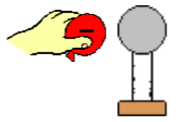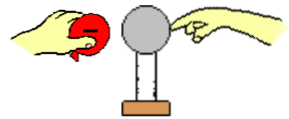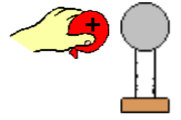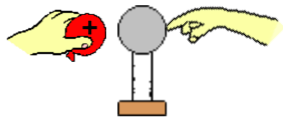This question is an example of charging by induction. Charging by induction typically involves a two-step process - a polarization step and a charging step. In the polarization step, a charged object (the balloon) is brought near to a neutral object (metal sphere). This induces a movement of electrons within the neutral object. Think about fundamental principle #3 (above) to determine how electrons move within the metal sphere. Consider whether electrons in the sphere will be repelled away from the balloon or be attracted towards the balloon.
In the charging step, the neutral object (metal sphere) is touched to a third object (sometimes referred to as the ground). There is a transfer of electrons between the third object and the neutral object. Once more, fundamental principle #3 will help you determine the direction in which electrons move. Consider whether electrons in the sphere will be repelled further away from the balloon and into the hand or whether electrons in the hand will be attracted towards the balloon and enter the sphere.
In charging by induction, there is NEVER any transfer of electrons between the charged object and the neutral object that is being charged. Thus the charged object will keep the same amount and type of charge that it originally had.



